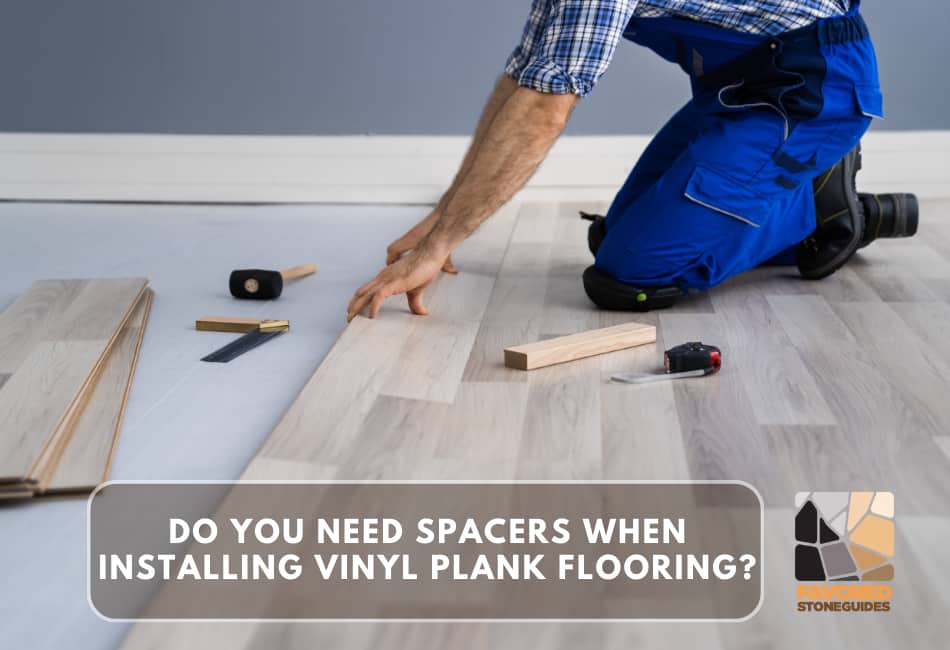The crisp, modern look of vinyl plank flooring has made it a popular choice for homeowners, but a common question arises during installation: do you need spacers? It’s a simple question with a surprisingly complex answer. When I renovated my kitchen a few years ago, I was quite sure I didn’t need spacers. I opted for a DIY approach, and my beautiful new vinyl flooring looked amazing – initially. But after a few months, I noticed some planks starting to buckle and warp. I had to rip it all up and start over. Turns out, those tiny spacers are crucial! Let’s delve into the world of vinyl plank flooring and explore the role of spacers in creating a long-lasting, beautiful finish.

Image: www.pinterest.com
Why Spacers Matter: Understanding Expansion and Contraction
Vinyl plank flooring, like most flooring materials, is susceptible to expansion and contraction. Changes in temperature and humidity can cause the planks to expand slightly. This expansion, if not managed correctly, can lead to buckling, warping, and even damage to the flooring. This is where spacers play a critical role.
Spacers, usually tiny wedges made of plastic or wood, are placed between the vinyl planks and the walls. They create a small gap around the perimeter of the flooring, allowing the planks to expand and contract freely without putting pressure on the walls. This gap, often referred to as an “expansion gap”, is essential for maintaining the integrity and longevity of your vinyl plank flooring.
Spacers: More Than Just a Gap
Spacer use for vinyl plank flooring goes beyond simply providing an expansion gap. They also help to:
- Prevent Uneven Flooring: Spacers create a consistent, even distance between the planks and walls, eliminating the risk of an uneven or sloped floor.
- Simplify Installation: When installing vinyl planks, spacers help to keep the planks aligned and prevent them from shifting during installation.
- Improve Overall Aesthetics: While the expansion gap created by spacers may be invisible, it ultimately contributes to a better-looking floor by preventing buckling, warping, and other visual distortions.
Choosing the Right Spacers
The type of spacer you choose depends on the specific size and shape of your vinyl planks. You can find spacers in various materials, including:
- Plastic: Affordable and readily available, plastic spacers are a popular choice for most vinyl plank flooring installations.
- Wood: Wood spacers are typically used for larger or thicker vinyl planks, offering additional strength and stability.

Image: favoredstoneguides.com
Tips for Using Spacers
Here are some key tips for using spacers during vinyl plank flooring installation:
- Use Spacers Consistently: For best results, use spacers around the entire perimeter of the flooring, including around doorways and other openings.
- Follow Manufacturer Instructions: Check your vinyl plank manufacturer’s instructions for specific spacer recommendations. Some manufacturers may recommend specific spacer sizes or materials.
- Use a Spacer Tool: To ensure consistency, consider using a spacer tool to maintain the correct spacing between planks during installation.
- Remove Spacers After Installation: Once the vinyl plank flooring is fully installed, you need to remove the spacers. Using a utility knife, carefully cut away the spacers, ensuring that no residual material is left behind.
Expert Advice: Don’t Skip the Spacers!
Despite the small size and seemingly insignificant nature of spacers, they play a crucial role in the success of your vinyl plank flooring installation. Not using spacers can lead to costly repairs – as I learned the hard way!
For the best results and peace of mind, always use spacers during vinyl plank flooring installation. If you’re unsure about anything, consulting with a professional flooring installer is always a good idea.
FAQs About Spacers for Vinyl Plank Flooring
Here are some frequently asked questions about using spacers for vinyl plank flooring:
Q: Do I need spacers for every plank?
A: No, you only need spacers around the perimeter of the flooring, along walls, doorways, and other openings. The goal is to allow for expansion and contraction, so you don’t need spacers between each individual plank.
Q: Can I use any type of spacer?
A: While you can choose from various materials, it’s best to consult your vinyl plank manufacturer’s guidelines for specific recommendations. Not all spacers are created equal, and some materials may work better with specific types of flooring.
Q: What happens if I use the wrong spacers?
A: Using the incorrect spacers can lead to uneven flooring, buckling, and other issues that may affect your flooring’s performance and aesthetics.
Q: How do I remove the spacers once the flooring is installed?
A: After installation, you should carefully remove the spacers using a utility knife. Be sure to remove any residual material that might be left behind.
Do You Need Spacers For Vinyl Plank Flooring
Conclusion: Understanding the Importance of Spacers
Vinyl plank flooring is a beautiful and practical choice for many homes, but it’s essential to understand the importance of spacers. They prevent buckling, warping, and other issues that can arise from expansion and contraction.
By using spacers correctly and following the manufacturer’s guidelines, you can ensure your vinyl plank flooring looks its best and lasts for years to come. So, don’t skip the spacers – they’re not just a small detail; they’re essential for a successful and lasting installation!
Are you planning to install vinyl plank flooring in your home? Have you ever used spacers? Share your experiences and insights in the comments below!





